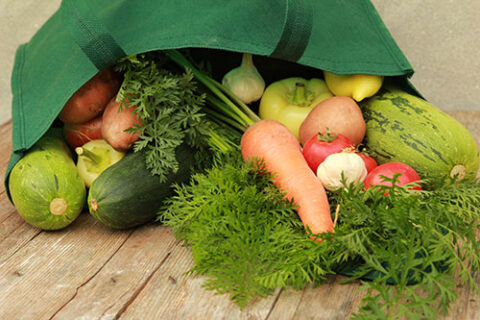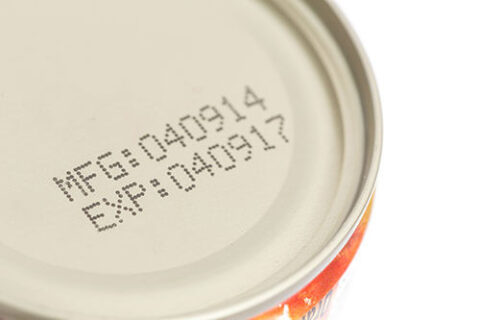To many of my friends and my online community, I’m the “queen of green.” I drive a hybrid, live in a passive solar house, compost, recycle to the max, and work as a climate change activist and green living guru. But until recently, knowing how to reduce food waste was not my forte.
When it came to food, I used to have only two real priorities: buy organic and eat less meat. What I didn’t think about much at all was food waste. In fact, this used to be my Saturday morning ritual:
Go to the grocery store early to beat the crowds.
Come home and put bags full of food on the kitchen counter.
Start cleaning out the refrigerator, making room for all the new food by throwing out the old.
I used to throw away so much food that I’d just keep a trash bag or my compost bucket right next to the fridge so I could streamline the process.
I realized that I—like millions of us—buy too much food; don’t eat what I buy; and am ruled by menacing, but meaningless, expiration dates.
Sure, I felt a pang of guilt at how much I was throwing way. But in the scheme of things, it didn’t seem like a very big deal. And besides, if I was composting the old food, I wasn’t really throwing it away, right?
That cavalier attitude came to a screeching halt after I read an eye-popping report on how much food Americans trash—and what a huge toll that’s taking on the planet, let alone our pocketbooks.
The report, Wasted: How America Is Losing Up to 40 Percent of Its Food, gave me a real wake-up call. Among other statistics, it stated that, based on an analysis from the U.S. Department of Agriculture, my food waste was probably costing me about 40 percent of my total food budget. In other words, I was wasting forty dollars of every hundred I spent, the equivalent of throwing away two full bags of groceries for every five I bought. Ouch!
The environmental statistics were no less staggering. Here are the four that really got me:
1. Total food waste in the U.S. amounts to more than more than 400 pounds of food per person per year.
2. If we could redirect just one-third of the food we toss to people in need, we could feed 50 million people, far more than the unmet food needs across the country.
3. Growing, producing, transporting, selling, and then throwing away the food we waste generates climate change pollution equivalent to 37 million cars per year.
4. Wasted food also squanders 21 percent of the water used by the U.S. agricultural industry.
As the reality of my wastefulness sank in, I started to wonder: Why did it happen, especially when it cost people so much money?
I thought about my own food habits and I realized that I—like millions of us—buy too much food; don’t eat what I bought (as ridiculous as it sounds); and am ruled by menacing, but meaningless, expiration dates.
I decided to make some simple but specific changes to how I shop, cook, store, and consume what I buy. Right away, I noticed a huge change in how much food I was throwing away—and how much money I was saving when I shopped. I’m sharing what I learned with you in case you’d like to waste less and save more, too.
How to Reduce Food Waste: Buy Less Food
I started limiting what I bought to what I planned to actually cook. That meant doing some meal planning before I went shopping. Happily, I discovered several apps and websites that make weekly meal planning a breeze.
MealPlannerPro.com lets me store my favorite recipes in an online bank then move them onto my weekly calendar and generate a list of ingredients I can take with me when I shop.
CookSmarts.com costs a nominal monthly fee but adds a lot of fun bells and whistles, like diet options, a fitness “pal,” the ability to tailor recipes to the number of servings I actually need, and suggestions to help users reduce food waste.
TheScramble.com generates a weekly meal plan and grocery lists based on healthy recipes that can be customized based on food preferences and family schedules.
I started limiting what I bought to what I planned to actually cook.
Some people have found that using their store’s meal planning and home delivery service also helps them shop smarter. My local supermarket does deliver, but it doesn’t provide the meal planning service that makes the biggest difference.
I tried not to get sucked into sales, especially 2-for-1 offerings for fruits and vegetables. Unless you’re terrific at freezing, dehydrating, or canning food, fresh produce goes bad quickly. For me, a key strategy was to reduce the amount of perishable food I kept “on hand.” I still bought non-perishable snacks and, of course, my fave, mango gelato.
I stopped buying pre-washed and packaged lettuce, spinach, and those oh-so-adorable mixed baby greens. Apart from not wanting to use more plastic, I realized that I usually ended up throwing away at least a third of those packaged greens because I never used them up before they got slimy in the bottom of the bag.
Besides, I discovered that if I cut off the bottom of a head of fresh lettuce and then kept the cut end in water in the fridge, the fresh lettuce lasted quite a bit longer than if it was bagged.The plastic bagged greens only saved me about three minutes in prep time in the kitchen anyway, a benefit definitely not worth the waste.
I also decided to limit my impulse buying to just one interesting item a week. I love trying new foods, but experience has taught me that a little may go a long way when it comes to new sauces, dips, and snacks.
However, to give myself an added incentive to shop smart, I started rewarding myself with one “splurge” a week, whether that was a high-end olive oil or some delicious organic chocolate. With all the money I was saving by not over-buying, I could afford it.
How to Reduce Food Waste: Eat What You Buy

Leftovers should be every busy woman’s friend. They save you hours of time because they’re already cooked. They save you money because you can take them to work and eat them for lunch or a snack rather than buy take-out. And the miracle of leftovers is that they often taste better than the original meal.
But like a lot of people’s, my leftovers would usually end up forgotten in the back of the refrigerator, where they would morph into moldy fuzz-coated glop that I wouldn’t feed to the rats at the dump.
Leftovers should be every busy woman’s friend. Today, my rule of thumb is to consume leftovers the day after the original meal is cooked.
Today, my rule of thumb is to consume leftovers the day after the original meal is cooked. That means I eat Monday night’s chili for Tuesday’s lunch. Or I use Monday night’s chili to make Tuesday night’s enchilada filling. You get the picture.
On Friday, if any leftovers linger, I pull them out of the fridge for a potluck meal. Instead of doing a big food dump Saturday mornings, I do a leftovers cook-off Friday night.
I’ve also made it easier to keep track of leftovers by storing them in clear glass bowls or containers like ones you can buy from your supermarket, hardware store or Amazon.
I personally skip plastic containers if I can; in fact, I never put hot food in plastic because I worry about the chemicals in plastic leaching into the food. But you don’t need to buy a lot of glass containers to get started. Clean empty jam jars, spaghetti sauce jars, and Bell jars work just fine.
I keep track of leftovers and fresh food alike by storing them in pull-out drawers I keep on top of my refrigerator shelves. The drawers make it easy to see what’s in the back. I also dump food like strawberries, blueberries, green beans, and brussels sprouts out of their packaging and put them in clear bowls so they’re more accessible and noticeable.
How to Reduce Food Waste: Ignore (Most) Expiration Dates

That’s not to say that some food won’t spoil. It will. Fresh fruit and vegetables only last so long, but you can figure that out simply by looking at them. I personally pay attention to “sell by” dates for chicken and fish, as I have found that those items turn pretty quickly, usually within a week. I don’t eat meat, but the same rule applies. However, many dairy products and most canned and dried goods last far longer than the dates printed on their wrappers.
Expiration dates are only the producer’s recommendation, not a guideline for safe consumption.
The website EatbyDate.com was set up to “debunk the myth of expiration dates on food” and offers a lot of reassuring guidance for what should be tossed when.
Of course, buying less food and cooking what I buy means very little of my food goes bad any more, regardless of the expiration dates printed on the package.
My Results
Once I started planning my weekly meals and shopping from a recipes-driven ingredients list, I still saw a 40 percent impact – but it was in 40 percent of my food budget saved rather than squandered. I went from throwing away an embarrassing amount of food to tossing almost none at all. I actually started eating better, too, since I was cooking more than carrying out and eating all my delicious leftovers instead of fast food.
I went from throwing away an embarrassing amount of food to tossing almost none at all.
The bottom line?
It wasn’t hard to make these few changes to my cooking and eating habits. It just required me to be intentional about it. I guess that’s the way it is with almost any behavior we want to change, isn’t it?
Quick Tips for How to Reduce Food Waste by Saving Food Before It Goes Bad
Going out of town? Squeeze lemons and limes into juice, then freeze the juice in ice cube trays. Add the cubes to sparkling water or a mixed drink when you return home.
Puree berries in a little yogurt or lemon water and freeze into popsicle molds.
Freeze butter still wrapped in its paper wrapping in an airtight container, or store it in the box it comes in in.
Seal flour and other grains in a reusable Ziploc freezer bags. You could also pour them into glass jars and screw the lid on tight.
Saute peppers, carrots, and onions, then freeze them for later use in stews and soups.
Freeze unused milk in clean glass jars, leaving an inch at the top so the jar won’t break with the milk expands.





















0 Comments